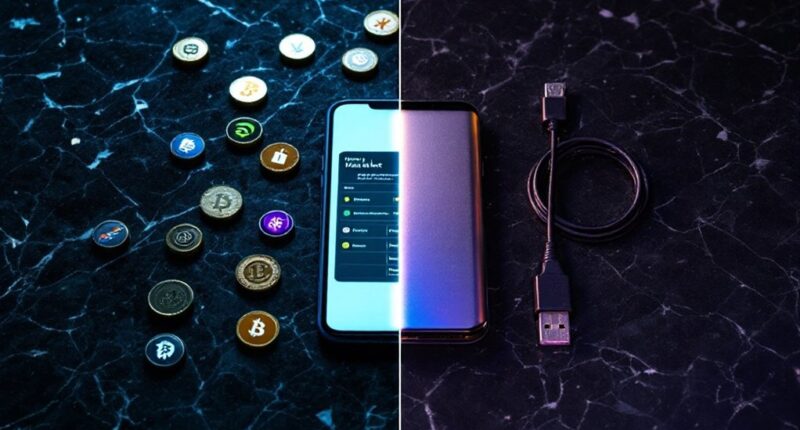Cryptocurrency wallets function like digital keychains that manage private keys proving ownership of digital assets. Hot wallets maintain constant internet connectivity for convenient trading but face higher security risks, while cold wallets store crypto offline for enhanced protection. Think of hot wallets as a checking account for daily transactions and cold wallets as a secure vault for long-term holdings. Understanding these differences helps users make informed choices about securing their digital wealth.

Cryptocurrency wallets, despite their name, don’t actually store digital coins – they’re more like sophisticated digital keychains that safeguard the keys to your crypto kingdom. These essential tools serve as interfaces between users and blockchain networks, managing the private keys that prove ownership of digital assets while enabling users to send, receive, and monitor their cryptocurrency balances.
In the world of crypto wallets, there are two main categories that often spark debate: hot wallets and cold wallets. Hot wallets, always connected to the internet, are like having cash in your everyday wallet – convenient for frequent transactions but potentially vulnerable to sticky-fingered hackers. Popular examples include Coinbase Wallet, MetaMask, and Trust Wallet, which offer user-friendly interfaces for managing digital assets on the go. Hardware wallets typically cost between $30 to $200. Some hot wallets like Exodus can connect to Trezor for enhanced security.
Cold wallets, on the other hand, are the digital equivalent of a bank vault, keeping cryptocurrency assets safely offline and away from internet-based threats. Hardware wallets like Ledger and Trezor, as well as old-school paper wallets, fall into this category. Think of them as the sensible shoes of the crypto world – not exactly flashy, but reliable when it counts. New investors often choose cold storage options for their enhanced security features when holding significant amounts of cryptocurrency.
Every crypto wallet comes equipped with essential components: a public key (like an email address for receiving funds), a private key (the secret password that authorizes transactions), and often a seed phrase (a string of words that can restore wallet access if needed).
Modern wallets also pack impressive security features, including two-factor authentication, biometric verification, and multi-signature support.
When it comes to choosing between hot and cold storage, it’s not unlike deciding between keeping cash in your pocket or in a safe deposit box. Hot wallets shine for their convenience and are suitable for smaller amounts used in daily transactions.
Cold wallets, while less convenient, offer superior security for larger holdings meant for long-term storage. The choice ultimately depends on individual needs, trading frequency, and security preferences, with many users opting to use both types for different purposes.
Frequently Asked Questions
Can I Recover My Crypto if I Lose My Hardware Wallet?
Yes, cryptocurrency can be recovered if a hardware wallet is lost or damaged.
The recovery process uses the wallet’s seed phrase – a unique sequence of 12-24 words generated during initial setup. By entering this seed phrase into a new hardware wallet, users can regain access to their funds.
It’s essential to store the seed phrase securely offline and never share it. Think of it like a master key that can open your crypto regardless of the physical device.
What Happens to My Crypto Assets if the Exchange Platform Crashes?
When a crypto exchange crashes, customer assets may be at risk since they’re often mixed with the exchange’s operational funds.
Without FDIC protection, customers typically become unsecured creditors in bankruptcy proceedings.
Recovery options include filing creditor claims, joining class action lawsuits, or seeking compensation through exchange insurance policies.
The best protection is preventative – keeping minimal assets on exchanges and using non-custodial wallets for long-term storage.
Are Hardware Wallets Worth the Investment for Small Crypto Holdings?
For small crypto holdings, hardware wallets may not provide sufficient value to justify their $50-$250 cost.
While these devices offer superior security through offline storage and private key protection, the investment makes more financial sense as crypto holdings grow larger.
Small investors often find mobile or desktop wallets provide adequate security with better convenience.
The break-even point typically occurs when potential losses would exceed the hardware wallet’s purchase price.
How Often Should I Transfer Crypto Between Hot and Cold Wallets?
Transfer frequency between hot and cold wallets varies based on individual needs and circumstances.
Active traders typically move funds daily, while long-term holders may transfer monthly or quarterly. A balanced approach considers factors like total holdings, risk tolerance, and transaction fees.
The key is finding a rhythm that maximizes security without sacrificing convenience. Most users keep minimal amounts in hot wallets for trading, transferring larger sums to cold storage.
Can Hackers Steal Crypto From a Cold Wallet That’s Not Connected?
While a disconnected cold wallet cannot be hacked remotely, physical theft, malware when briefly connected, and social engineering still pose risks.
The main vulnerability lies in compromising the recovery phrase – if obtained, hackers can access funds even without the device.
Additionally, supply chain attacks or firmware vulnerabilities could potentially expose private keys.
However, when properly secured and used as intended, cold wallets remain one of the safest storage methods.









